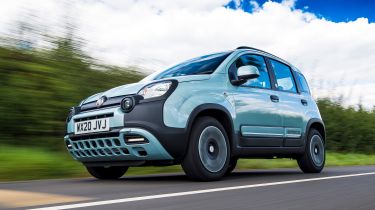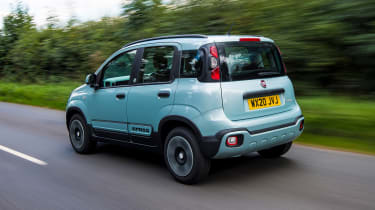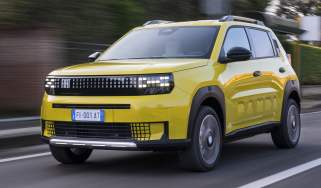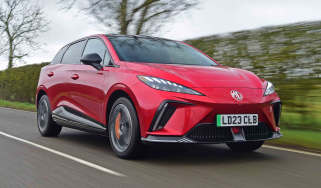New Fiat Panda Cross Hybrid 2020 review
New Fiat Panda Cross Hybrid aims to bring efficiency to small SUV segment
Verdict
Hybrid technology doesn’t do enough to mask the Panda’s age. It remains a charming and quirky car, but one that is almost impossible to recommend in today’s new car market. It’s incredibly slow, not all that fuel efficient and devoid of any sort of interior technology that buyers expect these days. At £14,730, it may seem cheap, but rivals are even more affordable - not to mention better to drive, easier to live with and considerably safer. Time for a reinvention, Fiat.
The Fiat Panda has turned the ripe old age of 40, but even stalwarts of the motoring world can’t escape the shift towards electrification. Fiat isn’t meddling with the formula too much, though, fitting the Panda with the mildest of mild-hybrid systems. It’s on sale in the UK now.
Under the bonnet is a 1.0-litre three-cylinder turbo petrol engine that has been paired with a 12-volt integrated belt starter generator, which is able to harvest and store energy lost during braking and deceleration in a small battery. That stored energy then allows the engine to shut down when coasting (providing the power steering with electricity, for example) and can even provide a very small amount of extra shove when accelerating. Well, that’s the theory.
In reality, the hybrid system - which is proudly plastered across the back of the Panda - is so mild that it’s almost impossible to detect. That isn’t necessarily a bad thing, but the physical benefits are in equally short supply. The only indication that the system is even there is a light that illuminates on the rev counter when you lift off the throttle; the engine cuts and then fires up like a regular stop/start system when you come to a halt. But not once on our test did the engine shut down when coasting.
Oddly, your rear passenger will be the only one to notice the system, because the battery hooked up to the mild-hybrid setup is located beneath the front passenger seat, thereby totally robbing that seat of valuable foot space.
Fiat claims that the Panda Hybrid will return over 50mpg, with CO2 emissions of 126g/km. That’s up on the 42.8mpg you’ll get from the Panda’s other engine option, a 1.2-litre unit. However, the Hybrid is so underpowered - it only develops 70bhp and 90Nm of torque - that you have to squeeze every last drop out of it in order to make any sort of progress. And as a result, there’s no way you’ll get anywhere close to 50mpg; we saw low thirties on our test.
As for the rest of the Panda’s driving experience, well, it’s a car that certainly feels its age. It’s easy enough to get comfortable, with plenty of adjustability in the driving position, but there is no place to put your left foot if you’re not changing gear. There’s a small shelf cut into the bulkhead tunnel in an attempt to make space, but it feels like an afterthought.
The Panda may be light, at just over 1,000kg, but with such modest power from the 1.0-litre engine (and only a small amount of electric assistance), you’re not going to be getting anywhere in a hurry. The Panda feels every bit as slow as 0-62mph in 14.7 seconds sounds, the only positive being the raspy exhaust note that the three-cylinder engine spits out.
On the move, the Panda’s raised ride height and softly sprung set-up make it a relatively comfortable car over rough surfaces, but hit a series of compressions and there’s very little body control, so the car pitches back and forth on its springs. Combine that with a tall body and compact footprint, and there’s a significant amount of lean through corners. The steering is light but totally devoid of feel, which can make faster, winding roads a little daunting.
When it comes to tech, the Panda feels even older than it actually is. Even the highlights of this Launch Edition - a top-spec model priced at £14,730 - only include Bluetooth, climate control and a full suite of airbags (remember, though, that the Panda was awarded zero stars from Euro NCAP).
By comparison, a top-spec Dacia Sandero Stepway is more fuel-efficient, more powerful and more spacious, and it comes with a multimedia system featuring Apple CarPlay, a reversing camera and cruise control. It's also £3,000 cheaper.
| Model: |
| ||
| Price: | £14,730 | ||
| Engine: | 1.0-litre 3cyl mild-hybrid | ||
| Power/torque: | 70bhp/90Nm | ||
| Transmission: | Six-speed manual, front-wheel drive | ||
| 0-62mph: | 14.7 seconds | ||
| Top speed: | 96mph | ||
| Fuel economy: | 50.4mpg | ||
| CO2: | 126 g/km | ||
| On sale: | On sale now |










